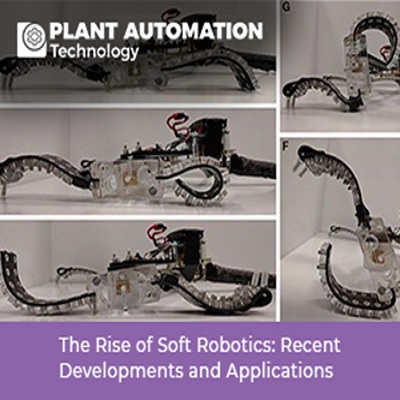The Rise of Soft Robotics: Recent Developments and Applications

Introduction
Traditional rigid-bodied robots have dominated the field of robotics for decades. However, in recent years, there has been a growing interest in soft robotics, a subfield that focuses on creating robots with flexible and compliant structures. Soft robots are inspired by natural organisms and mimic the flexibility and adaptability found in biological systems. This article delves into the fascinating world of soft robotics, exploring recent developments and their diverse applications across various industries.
Understanding Soft Robotics
1.1 Soft Materials and Actuators: Soft robots are constructed using flexible materials, such as elastomers, silicone, and textiles, which allow them to deform and adapt to their environment. The choice of soft materials is critical in determining the robot's compliance and range of motion. Additionally, soft actuators, like pneumatic muscles and fluid-filled chambers, are used to drive these robots' movements, offering a new approach to robotic motion.
1.2 Bio-Inspired Design: The concept of soft robotics draws inspiration from biology, imitating the mechanisms found in nature. Soft robots can emulate the movements of animals, such as octopuses, worms, and caterpillars, enabling them to navigate complex and constrained environments more efficiently. This bio-inspired design philosophy has opened up novel possibilities for robotics in exploration, medical applications, and more.
| Read More: Ethical AI in Action: How Robotic Companies Navigate the Future of Automation? |
Recent Developments in Soft Robotics
2.1 Soft Grippers and Manipulators: One significant development in soft robotics has been the design of soft grippers and manipulators. Unlike traditional robotic grippers, soft grippers can gently grasp delicate objects, making them ideal for applications in food handling, agriculture, and medical surgery. These grippers offer improved safety and dexterity when interacting with objects of varying shapes and sizes.
2.2 Soft Exoskeletons: Soft exoskeletons are wearable robotic devices that assist or enhance human movements. Recent advancements have led to more lightweight and flexible exoskeletons, providing support to individuals with mobility impairments or aiding workers in physically demanding tasks. Soft exoskeletons offer greater comfort and adaptability, promoting wider adoption in rehabilitation and industrial settings.
2.3 Soft Robots in Medicine: Soft robotics is making significant strides in the medical field. Soft robots can be tailored to move gently inside the human body, allowing for minimally invasive surgeries and targeted drug delivery. Additionally, soft robotic prosthetics offer enhanced comfort and natural movement for amputees, showcasing the potential to revolutionize the field of assistive technologies.
2.4 Soft Robotics for Search and Rescue: The flexibility and adaptability of soft robots make them well-suited for search and rescue missions in disaster-stricken areas. Soft robots can traverse challenging terrains, squeeze through tight spaces, and interact safely with humans. Recent developments in this area have the potential to improve disaster response capabilities and save lives in critical situations.
2.5 Soft Robotics in Exploration: In space exploration and underwater missions, soft robots can navigate complex environments more effectively than traditional rigid robots. The ability to deform and conform to irregular surfaces enables soft robots to explore caves, crevices, and rough terrain, offering new possibilities for space agencies and marine research teams.
Challenges and Future Prospects
3.1 Control and Sensing: One of the primary challenges in soft robotics is developing precise control mechanisms and sensors to monitor the robot's deformations. As soft robots have a more complex and dynamic behavior compared to their rigid counterparts, researchers are exploring innovative control strategies to improve their accuracy and performance.
3.2 Durability and Longevity: Soft materials used in robotics may be susceptible to wear and tear over time, impacting the robot's durability. Advancements in material science are essential to enhance the longevity and reliability of soft robots, especially in harsh environments or demanding applications.
3.3 Integration with AI and Machine Learning: Integrating soft robots with artificial intelligence and machine learning algorithms can enhance their autonomy and adaptability. By learning from their interactions with the environment, soft robots can become more efficient in accomplishing tasks and adjusting their behaviors as needed.
Soft Robotics in Human-Robot Interaction
4.1 Social and Companion Robots: Soft robotics has paved the way for the development of social and companion robots designed to interact with humans in a more natural and intuitive manner. Soft robots with expressive faces and gentle touch capabilities can engage in social interactions, provide emotional support, and assist in tasks that require a gentle and empathetic touch. These robots find applications in healthcare settings, eldercare facilities, and even as educational tools for children with special needs.
4.2 Soft Sensing Skins: One of the key advantages of soft robots is their ability to integrate soft sensing skins. These skins are made of flexible sensors, such as strain gauges and pressure sensors, embedded into the robot's body. Soft sensing skins allow the robot to sense and respond to external stimuli, enabling safe and compliant interactions with humans and delicate objects. This feature is particularly valuable in collaborative robotics, where robots work alongside humans in shared spaces.
Soft Robotics for Environmental Monitoring
5.1 Marine Exploration: Soft robotics has found remarkable applications in marine exploration. Underwater soft robots can adapt to the fluid environment, allowing for more efficient and non-intrusive exploration of delicate marine ecosystems. These robots can monitor underwater habitats, collect environmental data, and study marine life without causing disturbances. Their soft bodies make them less likely to damage sensitive marine structures or harm marine organisms.
5.2 Environmental Cleanup: Soft robots are being explored for environmental cleanup purposes, especially in areas where rigid robots might have limitations. For instance, soft robots can be used to collect and remove debris from natural disaster sites or contaminated environments. Their flexible bodies enable them to navigate through tight spaces and delicate terrains while minimizing further disruption to the ecosystem.
Soft Robotics and Future Challenges
6.1 Scalability and Mass Production: As soft robotics continues to evolve, one of the challenges lies in scaling up the manufacturing and mass production of soft robots. Developing cost-effective and scalable fabrication techniques is crucial to making soft robotics more accessible and commercially viable for widespread adoption across industries.
6.2 Power Sources and Autonomy: Soft robots often require external power sources, such as air compressors or fluid pumps, to actuate their soft actuators. Developing compact and efficient power sources that can be integrated into the robot's structure is essential for achieving greater autonomy and mobility, especially in untethered soft robotic systems.
6.3 Soft Robotics and Safety Standards: As soft robots increasingly interact with humans in various applications, defining safety standards and regulations becomes imperative. Ensuring that soft robots are safe, reliable, and compliant with international safety standards is essential for gaining public trust and acceptance.
Conclusion
The rise of soft robotics represents a paradigm shift in the field of robotics, emphasizing flexibility, adaptability, and safe human-robot interaction. Recent developments in soft robotics have showcased their potential in a wide range of applications, from healthcare and industry to exploration and environmental monitoring. By drawing inspiration from nature and leveraging advances in material science and control systems, soft robotics has unlocked novel possibilities for robotics and automation.
As research and development in soft robotics continue to progress, we can expect even more exciting advancements and breakthroughs in the coming years. Soft robots have the potential to revolutionize various industries, enhance human-robot collaboration, and address complex challenges in ways that were not possible with rigid-bodied robots. With ongoing innovations and interdisciplinary collaboration, soft robotics is poised to play a pivotal role in shaping the future of robotics and making a positive impact on society.







